We explain the importance of consuming a diet rich in the right kinds of nutrients, the timing of the consumption of those nutrients and how to fuel your training sessions. All of this so that you hit the day of your marathon with the highest level of fitness and best possible form.
We have written on such a wide variety of subjects in the past, many of which are relevant to this discussion, so where appropriate, we link out to these articles. Please take the time to follow the links if you would like to learn more about any particular area of interest. We pride ourselves in being extremely thorough and all the information you could possibly need to know on this subject is available on the TORQ website via these links. We have however deliberately kept this article as focussed as possible, sticking to the key topics and take-home messages.
The Macronutrients
The term ‘Macronutrients’ refers to the main food groups of carbohydrates, proteins and fats, each playing a pivotal role in our biological functioning. These macronutrients become even more important as we add the physiological stress of training for a marathon into the mix. These main food groups give us energy to exercise/train, assist in the post exercise recovery process and help us to maintain our overall health, keeping us free from illness. We’ll look at each one in turn:
Fat: Even the leanest of us store a significant amount of fat, so unlike carbohydrate, it’s not a nutrient we need to search for to fuel endurance exercise – it’s not a fuel we will ever run out of. That said, sourcing fats from the diet assists with the absorption of vitamins A,D,E & K which are known as fat soluble vitamins. Fats also provide structural roles which supports the formation of cell walls, helps regulate cholesterol and even extends as far as supporting brain development. It’s important to note however that fat is exceptionally calories dense, providing 9kcal per gram, so when sourcing fat from the diet, you really should be aiming for quality over quantity. Saturated fats are generally lower quality and typically found in poor quality fatty meats, butter, cream, savoury snacks and processed foods. Unsaturated fats, especially those containing high levels of Omega 3 oils should however be consumed in low quantities and provide the health benefits discussed above. Unsaturated fats with healthy Omega 3 content can be sourced from foods such as oily fish, avocado, nuts and seeds to name a few.
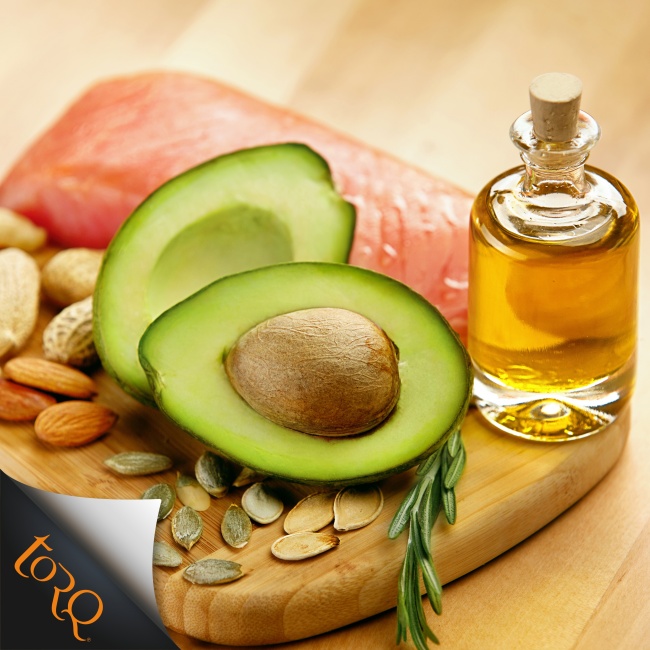
Interestingly, because we’re known to burn a lot of fat as a fuel when we train for a marathon, mistakenly many people think it makes sense to consume plenty of it. This couldn’t be further from the truth, because actually every calorie we consume which is in excess of requirements is stored as fat – so you don’t need to eat fat to retain stores of fat.
Protein: We have discussed protein in great detail in our article Protein, Performance & 20-25g Protein Recipes so please take the time to read it if you would like comprehensive information on this vital nutrient. Protein is responsible for building our physical human structure as well as controlling how the cells within our body function. The human body is made up of tens of thousands of different proteins that make up who we are. From skin, hair, tendons and muscle tissue, to the enzymes that breakdown our food and the hormones that control blood glucose such as insulin, each protein has a specific function. Unlike fat and carbohydrate, protein can’t be stored within the body and so it’s important that we consume it at regular intervals (every 3-4 hours) throughout the day, aiming for around 20g-25g per serve. This becomes incredibly important if you’re training your body for a marathon, because these regular intakes of protein will fast-track recovery and adaptation, helping you to become stronger as well as remain healthy. Our Protein, Performance & 20-25g Protein Recipes article will give you plenty of ideas as to how to find foods and make meals containing 20-25g protein. Our Explore Breakfasts for instance, each contain 25g of protein and can be eaten at any time of day, so are really convenient and effective.
As protein allows us to grow, repair and adapt, it of course plays a critically important role in post-exercise recovery and adaptation. This is why we formulated TORQ Recovery Drink, because it delivers an optimal blend of 20-25g of high quality protein with multiple-transportable carbohydrates (we discuss carbohydrate next) and is to be consumed immediately after exercise when the nutrients are most in demand by the body. Protein consumption of course doesn’t stop there – you need to remember to have more 3-4 hours later and then again 3-4 hours after that! Protein is much less energy dense than fat, providing 4 kcals per gram and can be sourced from foods such as red and white meat, fish, eggs, cheese, tofu, beans, pulses, nuts and seeds. With protein being such an important nutrient to help us repair and adapt from our marathon training, we remind you once again to read our afore mentioned article, where you can learn more about protein, high protein foods and we provide recipes for some delicious meals to build into your weekly menu.

Carbohydrate: The main role of carbohydrate is to provide your working muscle and major organs with fuel to function. Carbohydrates are broken down to produce ATP (the energy currency of our cells) during both light and intense exercise. Carbohydrates are stored, albeit to very limited quantities, within the human body as liver and muscle glycogen, at a maximal quantity of around 500g (2,000kcals). Because carbohydrates can be rapidly broken down for fuel, they become the preferred fuel source as exercise intensity progresses.
Carbohydrates are commonly categorised into two forms, simple and complex variations. Simple sugars are short chain carbohydrate molecules which are sweet and are found naturally in sweet-tasting foods like fruit and honey. Regular sugar (also simple sweet carbohydrate) is added to many processed foods for sweetness, which tend to have a bad reputation from a health perspective, often because they are mixed with higher fat foods to produce, for instance, chocolate, cakes and biscuits. Complex carbohydrates are formed from longer chain carbohydrate molecules, are less sweet and typically found in foods such as rice, pasta, potatoes, grains, and bread. These are generally considered healthier, especially in their wholemeal/wholegrain forms because they contain fibre and a variety of other micronutrients (vitamins & minerals) as well as often some protein. That said, from a functional perspective, carbohydrate is carbohydrate and if you’re putting some serious miles in to your marathon training, simple sugars represent a very handy way of taking on board extra carbohydrate calories – calories that you need. For instance, you will double the carbohydrate content of a piece of toast if you put honey on it! Quite handy if you need the calories and it has the additional benefit of making the bread easier to eat.
During exercise it’s a different story and we will talk about this shortly. Just like protein, the energy density of carbohydrate equates to 4 kcals per gram, yet stores of carbohydrate can be rapidly depleted in as little as 1.5 hours worth of exercise. When stores are entirely depleted, your ability to run will cease – this is called ‘hitting the wall’ in marathon running. Therefore, the ingestion of carbohydrate, pre, during and post exercise should be considered highly important for anybody training for an endurance event such as a marathon.
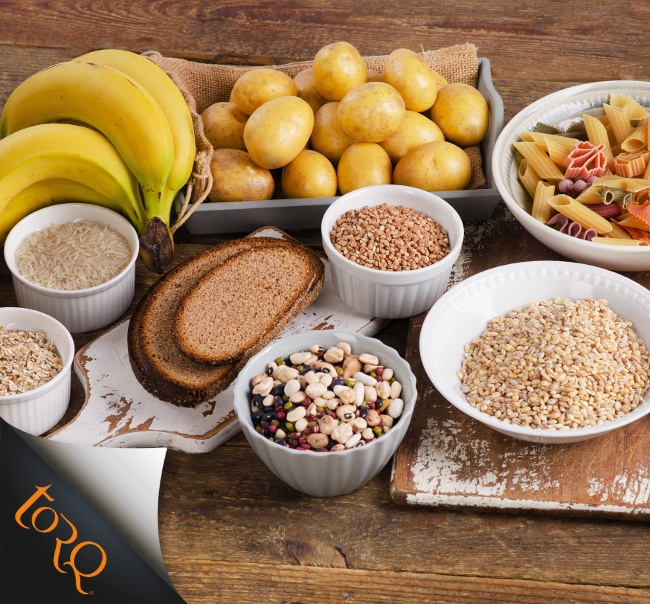
The Micronutrients
Micronutrients include vitamins and minerals and are consumed in much smaller quantities than the larger macronutrients. Although we don’t need much in the way of volume when it comes to micronutrients, this doesn’t mean that they’re any less important. Deficiencies however are much less likely to show immediately, so you’re not going to ‘hit the wall’ because you didn’t take a vitamin pill, but over time, your recovery and overall health could be compromised if you neglect this area. You’re asking a lot from your body by training for a marathon, especially over the winter months when your immune system is likely to be in poorer shape, so the best advice we can give is to encourage you to eat plenty of fruit and vegetables and a wide variety of fresh foods. We’re not suggesting that you exclusively eat fresh foods, but the more of them you do, the more micronutrients you’ll get. Many of these foods aren’t rich in calories, so can be used to accompany your macronutrients.
Immune health is an area where you may benefit from a little extra help from taking supplements however, especially over the winter and this is why we developed our Immune System Support Products. We have also produced a comprehensive range of Immune System Support Resources too, which you can read at your leisure. The scientific evidence clearly points to most of us being deficient in Vitamin D over the winter months, Zinc can be depleted during exercise and that there are supplemental interventions we can employ at the first signs of cold or flu.
Quality Nutrition For Quality Training
The human body is an exceptionally complicated structure, regulated by numerous mechanisms in order to maintain a state of homeostasis (balance). When we complete a training session, the core aim of the session should be to disrupt this state of homeostasis, generating training stress and inducing fatigue. Whilst fatigue is typically considered a negative by-product of training, it is actually fundamental to the training process. Referring to the graphic below, the fatigue generated by the training session (Phase I) will result in adaptations specific to the type of training completed.
For example, if you were to complete a 2-hour endurance training run (Phase I), this will have stressed all of the processes involved in driving the aerobic cardiovascular system. Once you have allowed some time to recover from the training (Phase II) we would expect to see aerobic-specific training adaptations starting to develop. Once fully recovered and adapted, you will now find yourself carrying a new heightened degree of fitness (Phase III).
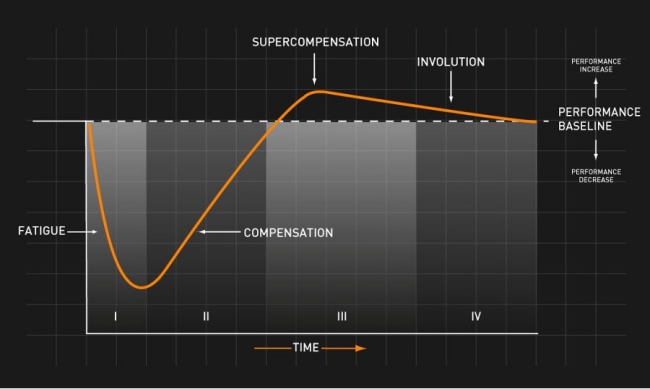
The key to successful training is all about taking advantage of these heightened levels of fitness and then generating a new fatigue stimulus, as demonstrated in the diagram below.
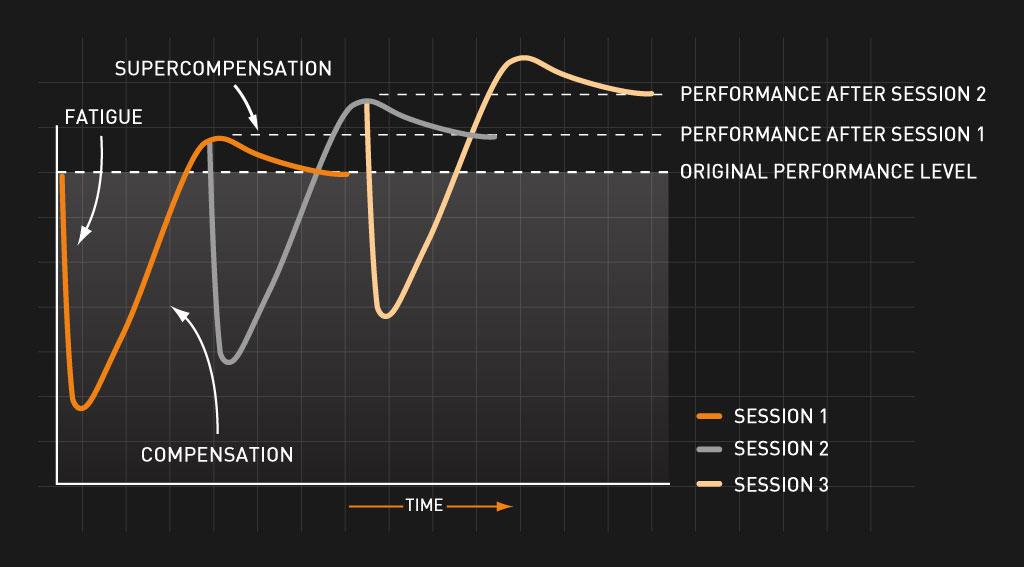
Consuming the correct nutrition at the right times will have a distinct impact on the effectiveness of our recovery and adaption as demonstrated in the diagram below. Consuming a high quality Recovery Drink immediately after exercise will deliver the key 20-25g of protein required as well as a heavy dose of carbohydrate and is by far the single biggest intervention you can make to fast-track your recovery. Remember, the quicker you recover, the sooner you can train again and the greater fitness gains you will achieve before marathon day.
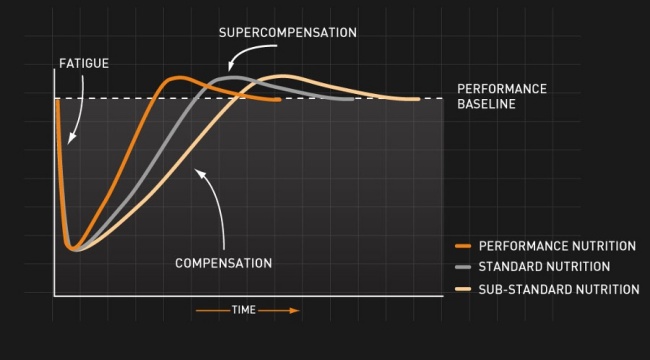
It’s hard to separate the importance of using a Recovery Drink from fuelling your training sessions properly, because the calories consumed whilst exercising are perfectly timed and have a direct impact on how fatigued you will be at the end of your training session. In essence, diligent fuelling will leave your Recovery Drink with less work to do. We will discuss ‘fuelling’ in the next section, but please take the time to watch the video below, which provides a solid summary on how to optimise your recovery.

The video (and previous discussion in this article) highlights how important it is to continue to consume high quality calories (protein and carbohydrate) throughout the day as all of this plays a vital role in your physical recovery and overall health. Remember to consume 20-25g of protein every 3-4 hours and maintain a high carbohydrate diet!
To learn more about the interaction between training and nutrition, we highly recommend reading our Optimal Nutrition article. Also, if you haven’t read our Immune System Support Resources yet, we strongly advise that you do. They explain how consuming carbohydrate during and immediately after exercise helps with immune function and there’s nothing more likely to cause regression in your training than illness. It’s so important that you keep yourself healthy.
You can learn more about Effective Training in this article. Also, if you would like to learn more about how to prepare, train and peak for your marathon, please take the time to read our Periodisation & Peaking series of articles:
Periodisation & Peaking 1: The Off Season
Periodisation & Peaking 2: Planning Your Training
Periodisation & Peaking 3: Peaking For Competition
Fuelling Your Training Sessions
When we exercise aerobically, typically at a low exercise intensity, both fat and carbohydrate provide the fuel to propel us. However, the proportion of carbohydrate contribution shifts upwards as the aerobic exercise intensity rises and this is shown in the graph below. As exercise intensity increases further, we start to work anaerobically (without the presence of oxygen) where carbohydrate is the only fuel that the body can use. In short, the harder we work, the more carbohydrate we burn and the more carbohydrate we need to consume as fuel to maintain our intensity. You will notice at 70% of our aerobic capacity, carbohydrate becomes the predominant fuel source and this is called the aerobic fuel utilisation crossover.
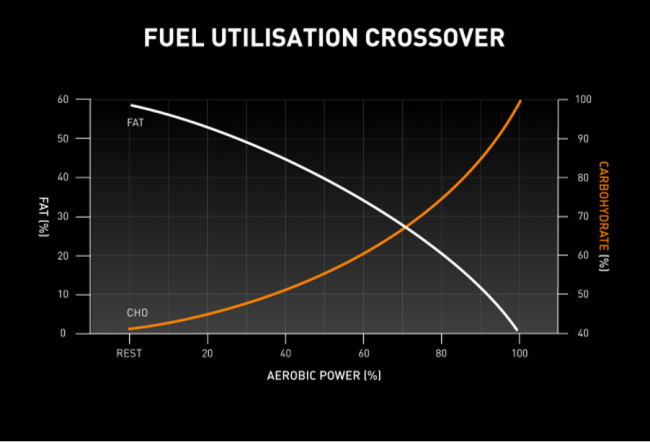
What the graph also highlights is that even at very low exercise intensity of 40% of our aerobic running pace, 50% of the energy contribution is coming from carbohydrate and so if our training run is of long duration at a steady pace, it could certainly still be possible to deplete our stores of carbohydrate if fuelling is neglected. The take home message here is that both high intensity and low intensity exercise drains our carbohydrate stores, it’s just that low intensity exercise does so over a longer time period.
We mentioned earlier that the human body can store about 500g or 2,000kcals of carbohydrate, which will keep you going for some time, but once this stored carbohydrate is used up, you will hit the wall and will be running nowhere! No Carbohydrate = No Performance. People don’t only hit the wall when running a marathon, they do it in training too and it’s not a great place to be. Not only is it a particularly unpleasant experience, but it will also severely impact your recovery.
The way to avoid running out of fuel, or delay the dreaded ‘hitting of the wall’ is to fuel with carbohydrate whilst exercising. The Why Fuel video below highlights the importance of fuelling for runners and demonstrates how taking on carbohydrate fuel sources (exogenous fuel) helps to preserve your stored carbohydrate (endogenous fuel). Please take the time to watch it, because it explains the topic far better than we ever could with words. This is a very valuable video to watch.

Although the video refers to energy drinks, gels and bars for fuelling, marathon runners often choose to use gels only and take on water for hydration at the feed stations. Gels are extremely easy to consume whilst running and we would always recommend them as the primary fuel source. We will talk about hydration shortly, but when training it can be handy to leave water bottles at hidden points on your longer runs so that you can take care of your fluid intake and practice the routine that you intend to follow when running the marathon itself. On hotter days where perspiration rates are higher, we recommend adding a Hydration Drink to your water bottles. Again, more about this shortly.
With the importance of fuelling now understood, the F.I.T.T principles will determine your day-by-day fuelling strategy and whether you should choose to fuel your sessions with 1, 2 or 3 TORQ Units per hour (30, 60 or 90g of carbohydrate).
The F.I.T.T principle is an acronym composed of the 4 methods used to manipulate your training load. These 4 methods include; Frequency (how many times per week you train), Intensity (how hard the session is), Time (how long the session is) and Type (sprint or endurance focused session).
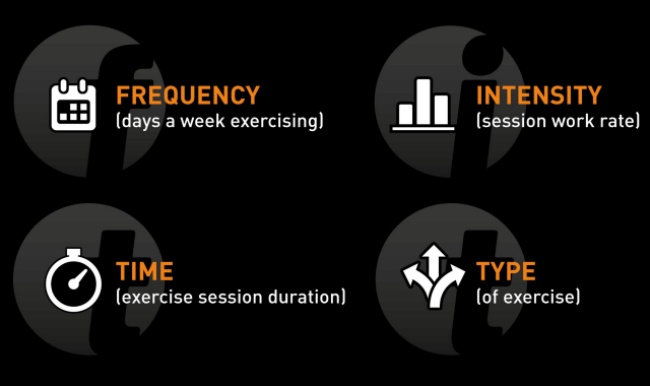
We have already discussed intensity and time, however the two principles yet to be considered are frequency and type. Regarding frequency, we may choose to schedule sessions back-to-back and strategically neglect recovery to generate a deep trough of fatigue, which (if a suitable period of recovery is planned) will generate a significant amount of adaptation.
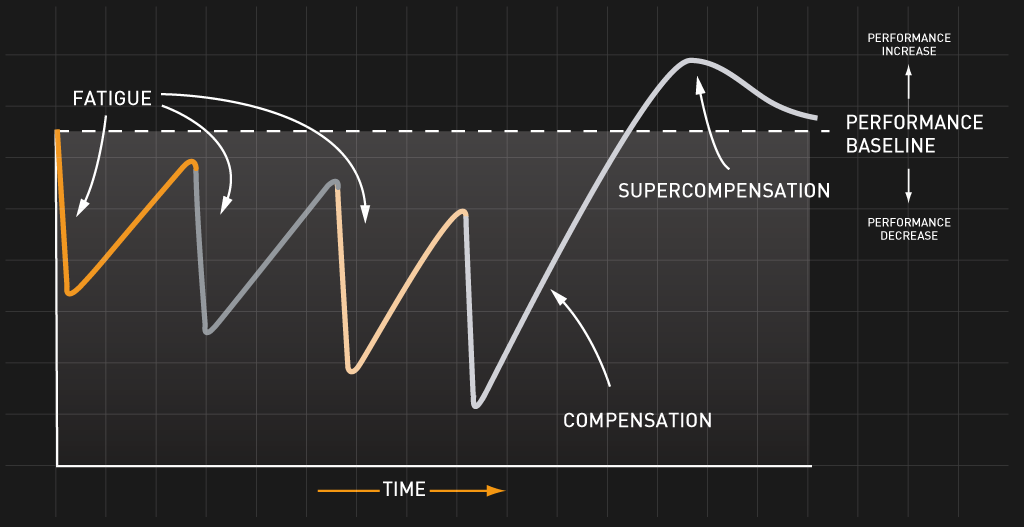
Training in this way could become unmanageable if your nutrition during exercise is neglected. When completing back to back sessions, your window of recovery is limited, so fuelling your training sessions helps to prevent the depletion of carbohydrate (glycogen) from your muscle and liver stores. This means that when you come to consume your recovery drink and subsequent meals, you have less of a deficit to replenish and the recovery between sessions becomes much easier. So, not only does fuelling your run sessions assist with the recovery process, but subsequently it also supports the adaptation process. The more training stress you can generate and the quicker you can recover, the fitter you will become.
The graph below highlights the comparison between a high and low carbohydrate diet and how the two diets impact stored carbohydrate availability over multiple sessions. Interestingly, the same graph could equally represent our performance within each session. As carbohydrate starts to deplete, we will almost certainly see a reduction in our ability to perform.
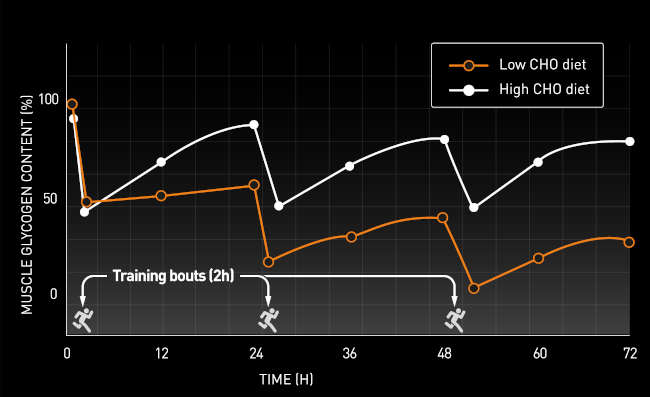
There are times when fuelling your training sessions may not be necessary. This is where we consider the Type (referring to the F.I.T.T principles) of our training. For example, on a short recovery run where the duration and intensity are both low, you will not run the risk of carbohydrate depletion. Also, if you want to introduce some advanced techniques into your training, you could consider some Fasted Training sessions, but these would need to be introduced with care and knowledge. By all means read our article on the subject HERE as there are some gains to be made, but if you’re at all unsure about implementation, stick to the basic principles in this article and you’ll run a great marathon.
For comprehensive information on how to fuel yourself effectively with TORQ Products, visit our TORQ Fuelling System pages. We make it very easy for you to follow and understand. The take-home message from this section is that on less draining training sessions, you won’t need too fuel much, so could consume 1 TORQ Unit (30g carbs) per hour. For most harder sessions, you should be looking at taking on board 2 TORQ Units (60g carbs) per hour. For particularly tough carbohydrate-draining sessions, you should aim for 3 TORQ Units (90g carbs) per hour and practicing this strategy as you approach marathon day will train your gut, giving you confidence that this strategy can be employed when it really matters during the event.
Carbohydrate Loading: Fuelling Your Longer Runs
On your longer training sessions, of course you need to fuel, but ensuring that you’ve got plenty of carbohydrate in the tank before you start will be equally as important. If you start with low liver and muscle glycogen stores, it’s likely that you will hit the wall as the amount of carbohydrate we can burn per hour can far exceed our maximal absorption rates of exogenous carbohydrate (fuel) at 90g/hr. Just like filling the petrol tank up in your car before a long drive, you should fill your muscular fuel tank up with carbohydrate before a long run.
Allowing sufficient recovery time prior to your longer runs and ensuring that your diet is rich in carbohydrate should be enough in the vast majority of situations, but there may be occasions where you want to complete a particularly long run, perhaps at a higher intensity than you would ordinarily? This is when you should consider carb loading.
When you carb load, we would highly recommended following the 1-day protocol discussed in our Carbohydrate Loading article as this has been shown to be far less disruptive to your life in general, whilst still offering all of the benefits of a traditional 6-day protocol. Don’t just eat more food, be strategic with your meals and increase the amount of carbohydrate within your daily diet to around 70-80% of your daily intake. You may also find it difficult to consume up to 80% of your daily calories from carbohydrate by eating food such as pasta, rice and potatoes, due to their bulky and more fibrous composition. To overcome this you will need to consider incorporating some simple carbohydrates such as jelly babies, wine gums, flavoured rice cakes (sweet or savoury) or even snack on a TORQ Bar or Explore Flapjack. Finally, stay hydrated! To store 1g of glycogen, 3 grams of water is required, so ensure you drink plenty of water and always have a bottle of TORQ Hydration to hand whilst carb loading. You can learn more about the intricacies of carbohydrate loading by clicking HERE.
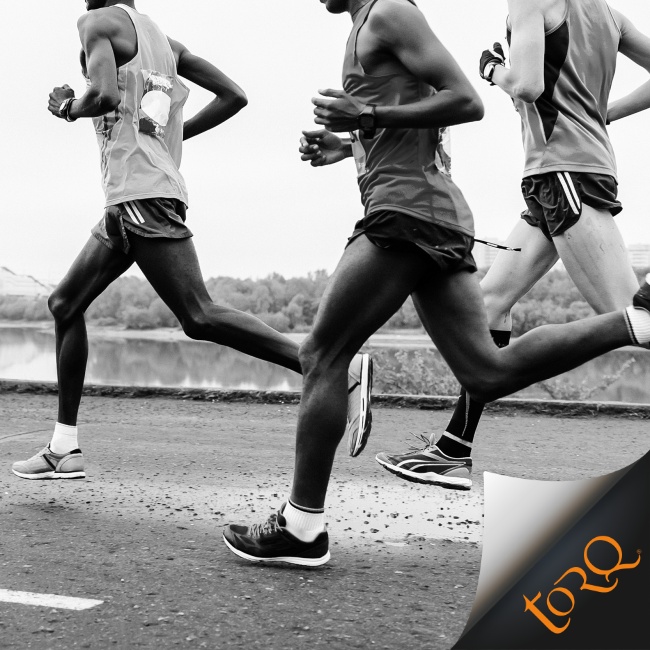
Hydration
The availability of water plays a huge role on various factors which affect and regulate our physical performance, so as we aim to maximise our marathon training, hydration is one factor that we should constantly pay attention to pre, during and post exercise. Hydration impacts our cardiovascular function, mental performance, ability to thermoregulate and impacts our ability to absorb nutrients such as carbohydrates. Electrolytes are also lost in sweat and these assist with the retention of water along with optimising muscle contraction.
If you’re fuelling your runs properly by following the TORQ Fuelling System, hydration should take care of itself. Take a look at the short video below. Although the tone of this video is perhaps directed more towards actual marathon day, the principles of fuelling and hydration remain the same. Please note that TORQ Hydration Drink is the new name for TORQ Hypotonic, which is referenced in this video – the product formulations are exactly the same.

Hydration is a hugely important topic and we encourage you to take the time to read our definitive Hydration Guide where we leave no stone unturned on the subject.
Conclusion
Getting your nutrition right is vitally important if you are to successfully fuel your training efforts and achieve the fitness gains you will need to perform at your best on marathon day. Ensuring that your diet is rich in carbohydrate, contains 20-25g doses of protein every 3-4 hours and is rich in fresh fruits and vegetables to provide an array of micronutrients is fundamental. Fuelling during exercise will support higher quality running sessions, boost recovery and ultimately improve your performance. Carbohydrate during and immediately after exercise will also support your immune system and you should also consider taking specific immune support supplements. A high quality Recovery Drink is strongly advised immediately after exercise, delivering both high quality protein and carbohydrate. Carbohydrate loading is advised prior to particularly long runs, or long runs requiring an elevated pace and ensuring that you remain hydrated at all times is not just critical to your performance, but to your ability to take onboard fuel.
Don’t forget to tune into our next article in the spring ‘Fuelling Your Marathon.’
If you have any questions about this article or any other subject, please don’t hesitate in contacting us at enquiries@torqfitness.co.uk or phone 0344 332 0852.






